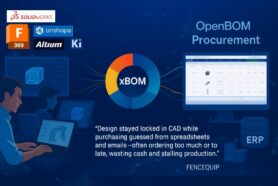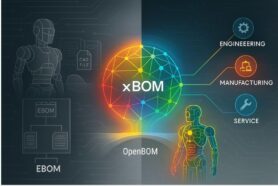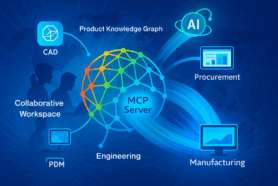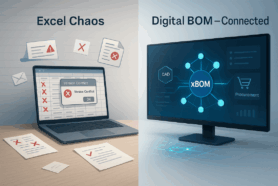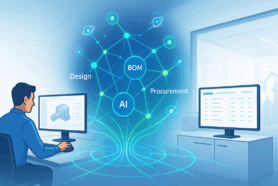
Single source of truth (SSOT) is one of the most fundamental concepts that has been coming alongside many organizations as a goal to establish their data management and data access practices over years. In a nutshell, it was about how organizations can access the same data without breaking it into silos. For many years, product lifecycle management was very much following the ideas of a single source of truth (SSOT architecture) in PLM systems and combining various systems into a system capable of representing a single source of truth, which in simple language means – a single database.
New Data Architecture and Digital Thread
Modern manufacturing methods and new technology are bringing a new way to think about data management and data access in manufacturing organizations. Products are becoming more complex and organizations are becoming more connected and distributed at the same time. Business decisions are relying on multiple sources of information and the demand for new technologies is to bring information and data updates from multiple systems in a single cohesive data set, but at the same time, keep the data in multiple systems. This is where the digital thread begins.
In my article going back in 2019 that I published in the Onshape blog, I wrote about What is PLM Circa 2020s? I wrote about the transformation of SSOT architecture. Here is the passage.
The previous generation of PLM systems were designed on top of an SQL database, installed on company premises to control and manage company data. It was a single version of truth paradigm. Things are changing and the truth is now distributed. It is not located in a single database in a single company. It lives in multiple places and it updates all the time. The pace of business is always getting faster. To support such an environment, companies need to move onto different types of systems – ones that are global, online, optimized to use information coming from multiple sources, and capable of interacting in real-time.
Isolated SQL-based architectures running in a single company are a thing of the past. SaaS is making the PLM upgrade problem irrelevant, as everyone is running on the same version of the same software. Furthermore, the cost of systems can be optimized and SaaS systems can serve small and medium-size companies with the same efficiency as large ones.
Distributed and connected SSOT architecture
A new perspective on data architecture brings a new way of thinking about SSOT. In fact, the key element in a new SSOT concept is not an ability to store the entire data set in a single database, but provide pieces of information that can be connected together in a cohesive data representation at any moment of time.
Jos Voskuil wrote about it in his article – The variable source of truth (in PLM). Jos gives an interesting perspective on the transformation from SSOT to ASOT (authoritative source of truth). Here is how it is defined by CIMdata:
New methodologies can be developed for this, as reliable data can be used in algorithms to analyze a change impact. This brings us to the digital thread. According to the CIMdata definition used in the A&D digital twin phase 2 position paper:
The digital thread provides the ability for a business to have an Authoritative Source of Truth(ASOT), which is information available and connected in a core set of the enterprise systems across the lifecycle and supplier networks.
The definition implies that, in the end, a decision is made on data from the most reliable, connected source. There might be different data in other locations. However, this information is less reliable. Updating or fixing this information does not make sense as the effort and cost of fixing will be too expensive and give no benefit.
Jos quoted a provoking statement about SSOT:
The “Single Source of Truth (SSOT)” wasn’t built for you. It was built for software vendors to get rich. Not a single company in the world has a proper SSOT.
The conclusion Jos is making is related to the transformation of PLM systems and data management paradigms. The SSOT and ASOT are illustrating that the traditional single database PLM paradigm is changing because of digital transformation and the connected behavior of the companies and their stakeholders. Now, the experience has to come.
Web Services and Connected SSOT
At OpenBOM we’re taking a modern approach to system and data management architecture. It includes forming a multi-tenant flexible data management platform capable of holding data and sharing it between multiple companies (Eg. OEM and Tier1-n suppliers) in the way it represents a connected data set. The data can be originated in multiple companies and be connected and shared using role-based access methods using multi-tenant data architecture.
In yesterday’s article –OpenBOM Data Management Platform, I brought examples of how OpenBOM Web Service architecture redefines a single database approach and provides a reliable data management foundation to manage product data shared between multiple teams and companies at the same time.
The key difference here is in the way OpenBOM web services provide a mechanism to replace an old fashion single database.
Conclusion
Manufacturing companies are looking for new types of software and data management architecture capable of supporting modern manufacturing companies in their NPI and supply chain collaborative processes. These are two examples of system requirements that provide the biggest pain to all implementors of traditional PLM architectures with isolated SQL databases and hosted (or on-prem) system deployment. OpenBOM provides users with unparalleled flexibility and scalability when it comes to data management. With its customizable interface and wide range of integrations, OpenBOM can easily adapt to any production environment. Whether you are manufacturing a single product or thousands, OpenBOM has the tools you need to get the job done.
Have questions on how OpenBOM works? REGISTER FOR FREE and start your 14-day trial to learn how OpenBOM can help you today.
Best, Oleg
Join our newsletter to receive a weekly portion of news, articles, and tips about OpenBOM and our community.





